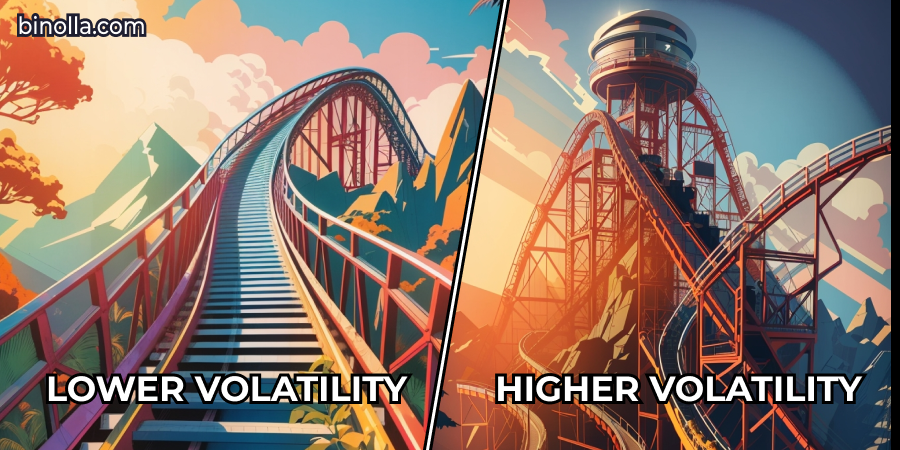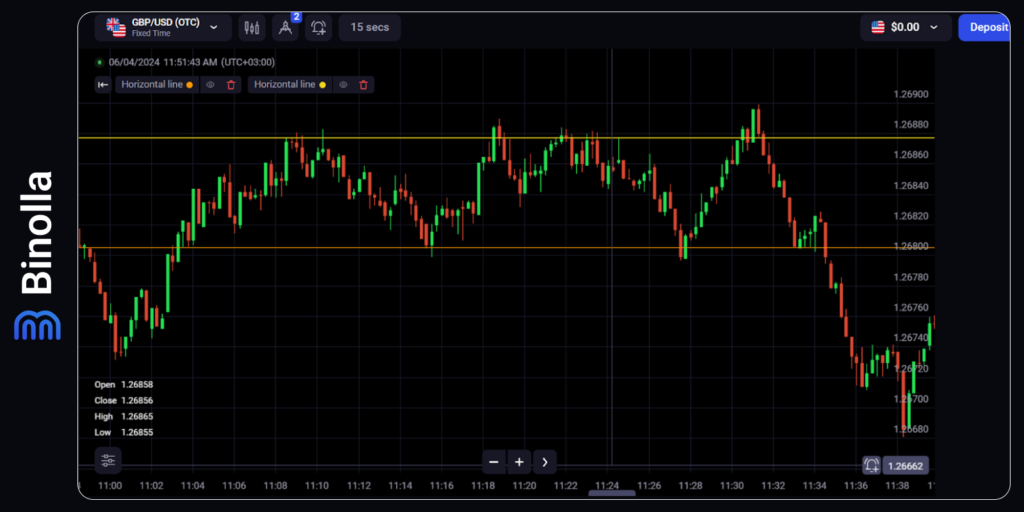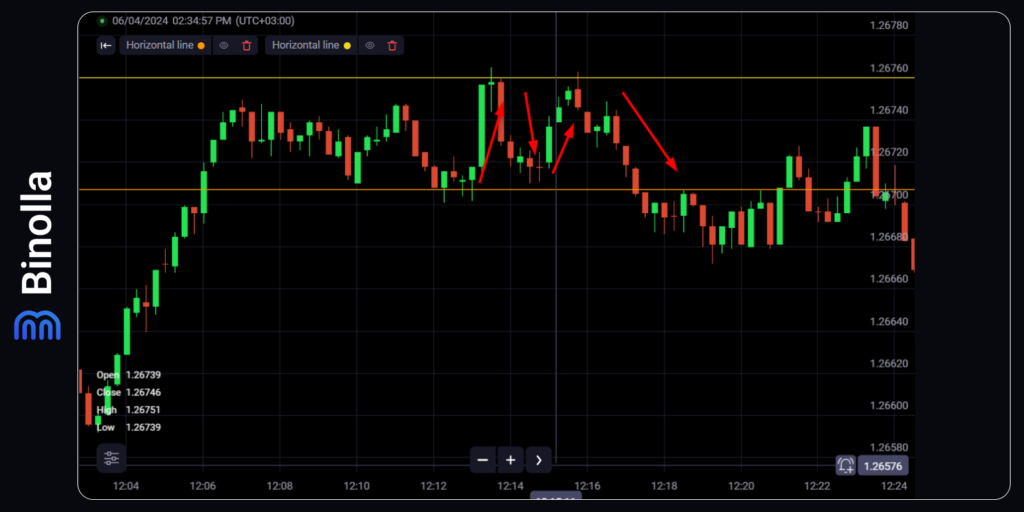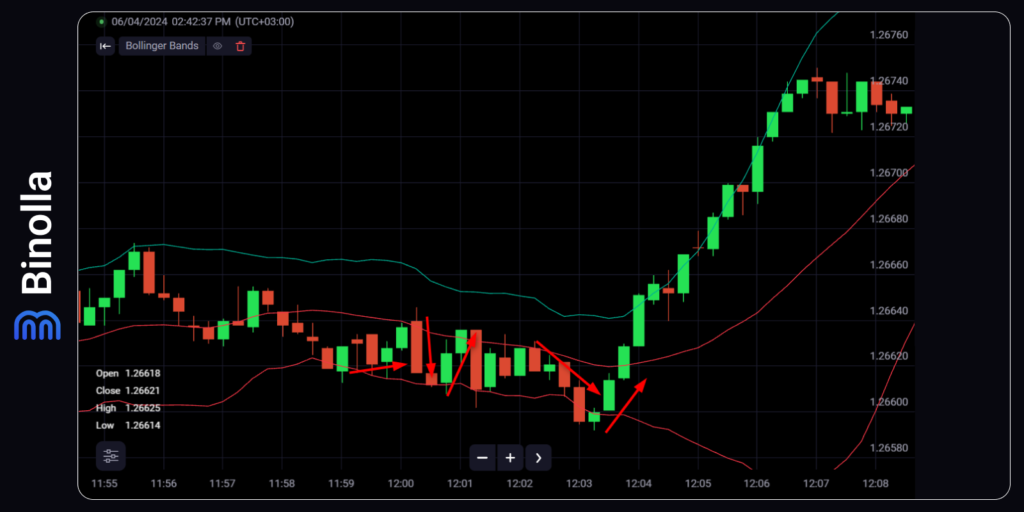Trading Strategies for Low-Volatility Markets

Traders love big trends that they can join aiming at higher profits. However, most assets fluctuate in narrow ranges most of the time. Traders have two alternatives at these moments. They can either stay away from trading or engage. If they choose the latter, they have to be prepared and know some aspects that will help them tackle the difficulties of low-volatility trading.
By reading this article, you will navigate through the features of low-volatility markets trading. Traders will learn more about the assets with the lowest and the highest volatility. We will provide you with some strategies that will help you to fit the calm nature of such markets. If you are ready to try out your skills in a low-volatility trading environment, create an account at Binolla now!
Contents
- 1 Low Volatility Explained
- 2 Lowest and Highest Volatility Assets
- 3 Lower Volatility vs. Higher Volatility: Which One Is Better for Traders?
- 4 Key Things to Consider for Trading Digital Options in Low-Volatility Markets
- 5 Practice low volatility strategies with Binolla!
- 6 Digital Options Low-Volatility Markets Strategies
- 7 Advantages and Disadvantages of Trading Digital Options in Low-Volatility Markets
- 8 FAQ
- 8.1 Should I Trade When the Volatility is Low?
- 8.2 How does low volatility affect digital options trading?
- 8.3 What strategies can be effective for digital options in low-volatility markets?
- 8.4 Are digital options suitable for all traders in low-volatility markets?
- 8.5 What are the risks of trading digital options in low-volatility markets?
- 8.6 How can technical analysis be used for digital options in low-volatility markets?
- 8.7 How can traders manage their risk when trading digital options in low-volatility markets?
Low Volatility Explained
Lower volatility in the financial markets is characterized by smaller price fluctuations without sharp trend momentum movements. Calm quotes movements are among the most preferable conditions for investors, while traders often lean towards more volatile assets seeking to capitalize on price momentum or significant one-sided movements.
Low and high volatility are measured when comparing different types of assets or even one single financial instrument. For instance, you can hear that cryptocurrencies are extremely volatile, while traditional fiat currencies boast low volatility. Moreover, volatility between different assets within a group may also be different. Finally, one asset can show different volatility at different moments.
Lowest and Highest Volatility Assets
Before going further, it is worth looking at groups of assets having the lowest and the highest volatility. Knowing them will be helpful as one can switch between those classes to find currencies or stocks that suit their trading styles and strategies. Moreover, understanding the estimated volatility of a particular asset will help you choose the right financial instrument (CFDs or derivatives).
For instance, while trading in medium and high-volatility markets can be done via different types of instruments, the best way to capitalize on low-volatility assets is to buy digital options contracts.
Currencies and stocks are traditionally among the assets with the lowest volatility, while cryptocurrencies show sharp price fluctuations most of the time:
- FX major currencies. Such currency pairs as EUR/USD, USD/CHF, USD/CAD, AUD/USD and other majors are considered to be assets with the lowest volatility as both currencies in these pairs are issued by strong economies with the US dollar, which is among safe havens;
- Cross-currency pairs. Unlike the previous type, cross-currency pairs boast higher volatility as they are not traded with the US dollar. EUR/GBP, for instance, boasts higher volatility as compared to EUR/USD and GBP/USD as the latter are impacted by the US dollar as well;
- Exotic currencies. While the US dollar is presented in most currency pairs of this group, their unstable economies stimulate higher volatility. If something negative happens in the Brazilian economy, for instance, USD/BRL may show high dynamics of fluctuations despite the fact that the US dollar may act as a stabilizer;
- Stocks. When dealing with stocks, one should be aware of the fact that even if they can boast low volatility, this parameter may vary from one group to another. Blue chips, for instance, are less volatile due to higher volumes of liquidity and a better reputation among investors. Pink sheets, on the contrary, can’t boast the same levels of liquidity and their volatility may be extremely high;
- Commodities. Various raw materials and raw food products traded on exchanges are considered more volatile as compared to major currencies and stocks, but the range and sharpness of their price fluctuations depend on a particular asset. Gold, for instance, is stable and can be compared to USD, while wheat’s volatility may be extremely high, especially in times of significant shifts in supply and demand;
- Cryptocurrencies. Unlike all the above types of assets, cryptos are famous for their high volatility, which attracts a lot of risky traders. The nature of high volatility in digital coins lies in their lower liquidity as compared to many other assets as well as a higher number of speculating traders capitalizing on sharp price movements instead of holding assets on a long-term basis.
Lower Volatility vs. Higher Volatility: Which One Is Better for Traders?

Trading assets with lower and higher volatility may be profitable, but it mostly depends on the strategy and the trading style that one chooses. Moreover, choosing between them may be directly impacted by one’s personal traits. Traders looking for large short-term profits often choose assets with higher volatility as they offer more entry points with higher gain potential. Investors, in turn, focus on low-volatility assets as their profits will grow over time.
Forex CFDs trading
When it comes to Forex CFDs trading, most traders prefer assets with higher volatility as they allow market participants to capitalize on large one-sided price movements, which can be 50+ pips instead of trying to buy and sell reversals within a small range.
Another reason for FX traders to search for higher volatility is the reward-to-risk ratio. If you expect at least 30 pips of profit, you can set stop losses at 10 pips. However, if the eventual profit is smaller, then a stop loss should be smaller as well in order to stick to a 3:1 ratio, which is considered the lowest possible for successful trading.
Stock Trading
The same is true for stock traders. They need higher volatility to profit from sharp one-sided price movements to save effort and stick to their reward-to-risk ratio. Stocks with lower volatility may be of particular interest to investors only as they offer an opportunity to collect profits over time (together with dividends). Therefore, those trading stocks look for shares with faster price fluctuations and wider trends.
Keep in mind that the volatility of the same asset may be different over time. A stock may trade faster during some periods (especially during the release of important fundamentals and reports), while in other periods its volatility may be extremely low.
Digital Options Trading and Low-Volatility Markets
The only category of traders who do not care about the market volatility are those trading digital options. Regardless of the current market situation, their gains depend on whether they were right or wrong about the direction of price fluctuations.
For instance, by buying a Higher contract on EUR/USD at 1.0820, one needs to predict whether the price of the asset will be at least 1.0821 at expiration. Therefore, one can capitalize even on a single pip price change when trading digital options with the potential to gain 85-95% of their investment amount.
Moreover, the nature of digital options allows market participants to use a different approach towards risk management. Unlike Forex CFD or stock trading, digital options traders are not required to use stop losses to protect their balances from excessive risks. They can’t lose more than they have invested in a single trade.
However, you should keep in mind that the approach to low-volatility market trading differs from that of high-volatility market trading. By reading the next paragraph, you will find some recommendations on the aspects to consider when trading digital options in low-volatility markets.
Key Things to Consider for Trading Digital Options in Low-Volatility Markets

When trading in low-volatility markets, traders should apply a different approach that includes a proper selection of trading strategies combined with expiration time and trading goals adjustment. One should also apply various risk management strategies to reduce risks connected to sharp price movements.
Setting Expiration
Digital options trading is about setting the right expiration. When it comes to low-volatility markets, being able to determine expiry times that will allow you to make successful trades is essential. When the price fluctuates in a narrow range and its speed is slower than usual, one should think about setting longer expirations. The Binolla platform allows market participants to choose between 5s and 4-hour contracts, which enriches the choice of the right expiration.
Technical Indicators
Trading in low-volatility markets requires precision as traders operate in an environment where price changes are minor. Utilizing technical indicators may significantly increase their chances of succeeding, especially when there is a clear entry signal provided by such tools. By using moving averages, Bollinger Bands and other indicators, traders can complete the following tasks:
- Identify the main price movement direction. The above-mentioned trend indicators along with other similar tools allow traders to be aware of the current price movement. Trading along the trend will allow them to be more confident about the probable outcomes when it comes to low-volatility markets. During the uptrend, market participants can search for opportunities to buy Higher contracts, while when the price goes in the opposite direction, one should think about purchasing Lower contracts;
- Measuring volatility. To navigate through the low-volatility markets, traders should know how to identify the points or areas where the price can reverse. Using Bolinger Bands or Average True Range may be very helpful in this case. Apart from indicating volatility, the Bollinger Bands indicator, for instance, can be used to find entry points to buy digital options contracts or Forex CFDs;
- Finding oversold and overbought areas. The arsenal of Binolla tools is not limited to trend indicators. It includes a lot of useful oscillators that allow market participants to identify so-called “oversold” and “overbought” areas. Relative Strength Index, Stochastic, and other oscillators help traders pinpoint such levels and find reliable entry points from there;
- Signals confirmation. Apart from providing traders with deep data about the current trend, volatility rate, or even eventual reversals, technical indicators can also be used to confirm signals. Before entering a trade, one can confirm the strength of the trend with the moving average or the eventual reversal by using the MACD divergence;
Range Trading Opportunities
The key aspect of range trading is to be able to identify apt levels from where you can buy Higher or Lower contracts. These levels known as support and resistance are psychological barriers preventing the price from moving higher or lower depending on the current market scenario. The price normally oscillates between them for some time offering various trading prospects, especially in low-volatility markets.

The idea of range trading is to profit from the price reversals when the quotes step back from support and resistance. You can buy a Higher contract close to the support level or right after the price changes its direction and starts moving upwards. Conversely, you can buy a Lower option somewhere near the resistance level or after the quotes hit it and change their direction.
These techniques provide you with an opportunity to make data-driven decisions based on the current situation on charts. By harnessing range trading strategies in low-volatility markets, you can profit from smaller price fluctuations without waiting for larger trends to appear. Additionally, the strategy allows traders to mitigate risks providing them with an opportunity to stay in control of their trading sessions.
Leveraging Fundamental Analysis
Adding fundamentals in your trading sessions may be critical for success. Regardless of the type of market you trade (low-volatility or high-volatility), the price may make significant movements driven by some key news releases and events having financial or economic background.
Such fundamentals as key interest rate decisions, GDP data, purchase managers indexes, employment reports and others may result in a shart momentum that will break the low-volatility range temporarily or even lead to mid-term or long-term trends.
Being informed about the upcoming data releases is of particular use, especially when trading digital options. Traders can do their research on the nature of the approaching release and make appropriate decisions.
For instance, if the upcoming report is expected to be neutral, one can buy digital options contracts expecting no significant change in the price landscape. Conversely, if the approaching data release is expected to result in a kind of market explosion, then, it is better to wait for the fluctuations to calm down before buying a particular options contract.
Apart from macroeconomic fundamentals that affect all types of markets and assets, those trading stocks should be aware of corporate announcements. Earnings reports are among the key ones when it comes to analyzing stocks. Other events, including mergers, acquisitions dividend payments and decisions are also of particular importance. Before buying any asset of this type, one should check whether there are any of these key corporate reports on the way.
Risk Management Approach
While digital options are considered low-risk financial instruments, traders should still think about how to protect themselves from excessive losses. This is where risk management comes into play. When it comes to low-volatility markets, some specific techniques can be applied to reduce the risks of losses.
- Adjusting position size. Before even placing the first trade, one should think about how much they are ready to risk per trade or session. It is recommended to use no more than 1-2% of the total trading balance per single position. This amount can be slightly increased or decreased depending on a particular market scenario;
- Assets diversification. Trading a single asset may be a great solution for beginners, but once a trader gains experience, they should think about diversification. In a low-volatility market environment, one can use different currencies, stocks, or even cryptocurrencies to maximize their profits and reduce their risks;
- Monitoring market conditions. The situation on charts changes all the time. Periods of low volatility may be replaced by those with wide price fluctuations and even strong one-sided trend movements. Traders should be on guard all the time in order not to miss any significant changes and be among the first to react to them;
- Hedging strategies. Utilizing a single trading strategy may be a good idea, but using a bunch of them will prevent you from being stuck in a single point of view. Enlarging your trading horizons will offer you a lot more trading opportunities. If a trader uses a candlestick reversal pattern, for instance, they can also apply oscillators to be more sure about the upcoming price behavior.
Digital Options Low-Volatility Markets Strategies

The easiest way to profit from low-volatility market price fluctuations is to find a narrow range and trade from its boundaries. Once the price tests the upper line, a trader can buy a Lower contract expecting the quotes to retreat from the resistance. Keep in mind that expiration should be short in this case as the range is narrow.
On the other hand, traders can also benefit from this strategy when the price reverses at the support level. One can buy a Higher contract at the moment the reversal is confirmed (this can be any candlestick pattern or other indicator).
Keep in mind that ranges are not forever. Once the price breaks any of the boundaries, the range is no longer relevant, which means that you should use other strategies to trade. Moreover, the volatility may increase at this moment, which will require you to change your trading style.

Using the Bollinger Bands indicator allows traders to check the current volatility and pinpoint potential reversal areas. In this particular example, both extreme lines are close to each other, which means that the asset has entered a low-volatility phase.
Similar to the previous strategy, in this one, a trader can buy Higher contracts once the price rejects the lower band and purchase Lower ones once the quotes reverse from the higher or middle band.
One of the benefits of using such strategies is that the price remains inside Bollinger Bands most of the time, which means that you will always be able to find signals. After the distance between the bands becomes wider, a trader should change strategies as this position indicates the increase in volatility.
Advantages and Disadvantages of Trading Digital Options in Low-Volatility Markets
Trading digital options in low-volatility markets come with its own set of advantages and disadvantages. Let’s have a closer look at them.
Pros
- More chances of succeeding. Low-volatility markets are more predictable when it comes to price fluctuations. When the price is in a range, for instance, one can expect it to move from its lower point to the higher one;
- Limited risks. Digital options are great for low-volatility trading with their limited-risk structure. Unlike many other assets, a trade does not need to worry about sharp price movements that may occur. Even if the price steps outside the range in the opposite direction, the trade will be closed with a loss that is known in advance;
- A variety of analysis tools. When trading in low-volatility markets, traders can use technical indicators, drawing tools and any other analysis methods to predict price fluctuations;
- Psychological resilience. When buying digital options or any other financial instruments, traders are more psychologically resilient as they see a clear corridor where the price fluctuates. However, this should not relax you as the situation may change at any moment, especially if key fundamentals are expected or released.
Cons
- Fewer trading opportunities. Low-volatility markets provide fewer trading opportunities throughout the day, which results in lower profits. Higher-volatility markets often have more reversals allowing market participants to capitalize on them;
- Risks underestimation. Periods of calm markets may lead to risk underestimation, which, in turn, may result in inappropriate market analysis. Traders may try to benefit from any opportunity even if there is no clear trading signal for engaging.
FAQ

Should I Trade When the Volatility is Low?
While most traders avoid trading in low-volatility markets, those choosing digital options have an advantage. They can use these fixed-payout contracts to capitalize on various markets, including those with calm and limited price fluctuations as such contracts are not dependent on the number of pips the price covers. Therefore, if you use digital options, you can trade in various scenarios, including markets with low volatility.
How does low volatility affect digital options trading?
The price movements are smaller during periods of lower volatility, which may affect CFD traders’ profits. When it comes to digital options, their income does not rely on the number of pips the price covers, which means that low volatility has no impact on digital options in terms of their profitability.
What strategies can be effective for digital options in low-volatility markets?
Most if not all strategies can be used by traders to benefit from low-volatility markets. The most interesting ones involve range-bound trading, where a trader buys higher options from the support line and lower contracts from the resistance level.
Are digital options suitable for all traders in low-volatility markets?
In general, digital options are suitable for all traders who choose low-volatility assets. This type of contract allows market participants to enjoy fixed risks and payouts regardless of the number of pips the price covers before expiration.
What are the risks of trading digital options in low-volatility markets?
The risks of trading fixed-time contracts are the same for all types of markets. Traders should carefully plan their investment strategy in order to avoid excessive losses.
How can technical analysis be used for digital options in low-volatility markets?
Technical analysis is 100% compatible with all strategies digital options traders use when trading low-volatility markets. Whether you prefer patterns or technical indicators, you can expect both to provide you with trading signals.
How can traders manage their risk when trading digital options in low-volatility markets?
Digital options are fixed-payout and fixed-risk contracts, meaning you can’t lose more than you have invested in a single trade. Therefore, to manage risks, one simply needs to avoid investing more than one can afford per single trade.







